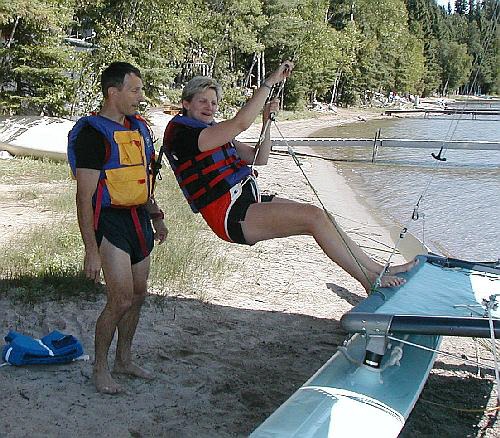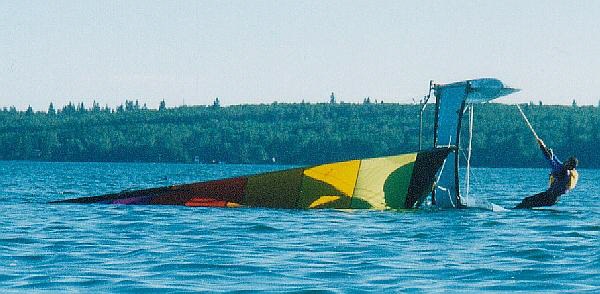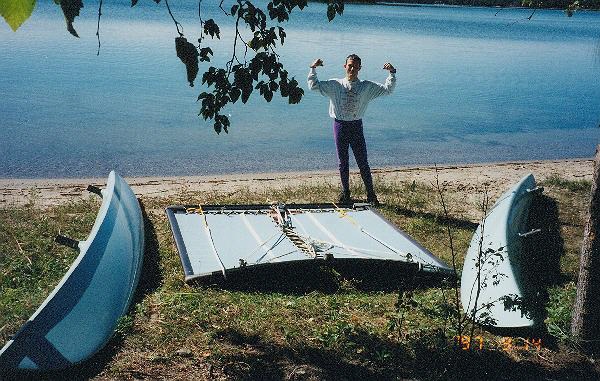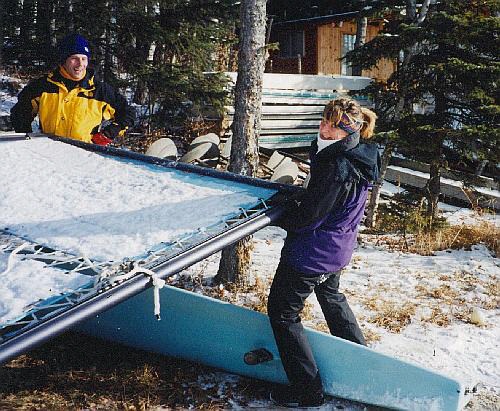 |
|
|
Crew: It is really nice to have someone out sailing with you. The HobieCat 16 is built for two and can easily handle 3. They don't need to be good, just willing. For the most part, total novices will have plenty to think about just learning how to use the trapeze. I can handle the rest pretty easily. As they get better, they can start helping you keep the boat trimmed. Once out on the trapeze, your crew can easily and rapidly move forwards and backwards. I have my crew way forward until we get up to speed and then rely on them to keep everything level. I like to keep the peak of my bottom bow about 6 inches out of the water. A good crewman can keep it right there. And can often react before a submarine happens, making my life much easier. I really like having my crew dancing up and down the hull. It is nice if your crew can handle the jib. In the PA Regatta one year, I was out with Chris as my crew. Chris is small, much lighter than even me, and the winds were about 35 knots. We were having a really hard time just keeping the boat upright. And, to make matters worse, Chris was having a hard time getting the jib to release. We got blown over TWICE in five minutes by the jib alone: the mainsail had already been released, and the jib was jammed into its cleat too hard for Chris to get it free. We probably would have gone over a few more times like that, except for the fact that the second time, our mast got jammed into the botton, and the wind drove it down 5 feet into the mud. We struggled fruitlessly for 20 minutes to free it, but couldn't do anything. So, a rescue boat came out, threw us a rope, and dragged us upwind.
A mast all muddy from being jammed into the bottom of a shallow lake. I have also spent time out on the trapeze, mostly as crew for Greg. Its a lot of fun, even more so when it isn't my boat and I just don't care what he does with it! Greg likes living on the edge: "If you aren't living on the edge, you are taking up too much space!". Here we are getting sheeted in for another run.
Some things to note:
On the trapeze: A trapeze is a wonderful thing. It enables your crew to join in the action much more so than just managing the jib. Think of a belt or harness attached to the top of the mast by a cable. Wearing a trapeze, you can stand straight out from the side of the boat.
Dalene tries out the trapeze. This is about all the presailing instruction I give anyone! Our Hobie16 is set up with dual trapezes. This means that the skipper can also get out. This also means that the boat is now being controlled by someone who is being jerked and tossed around just like the crew. Really fun, but I find that our winds are rarely consistent enough for me to be out on the trapeze with my crew. :-( It is easy to lose control of the boat when the wind drops or shifts and I am dunked and swept around to the back of the boat. Some people take to the trapeze easily. It really isn't that difficult and looks a lot more dramitic than it really is. Once you spend a little time out on it, you get used to it and it is almost relaxing. It does take awhile before people get really good at getting out on the trapeze quickly and on time though. Once the boat starts to heel over, getting out on the trapeze means climbing up. Maybe WAY up. And I really need my crew to be out there now, not sliding back down the trampoline! Tipping the boat: You are going to tip one day. Or viewed another way, one day, you are going to tip over a LOT. Greg says if you aren't living on the edge, you are taking up too much space. (I tend to agree with him, but am not allowed to say it out loud!) Most of my crew/passengers live in a panic about this happening. Then, when they have tipped three or four times, it is no longer a big deal, and they are ready to start enjoying themselves. There are basically 4 ways to tip the boat:
The first is pretty much due to skipper error: failed to release the main sheet cleated. Sometimes you can claim extenuating circumstances: e.g. the main sheet (the rope you use to adjust the mainsail) has been swept away by a wave and you can't even find it, never mind release it!. Not that this has ever happened to me! You soon learn to always have the main sheet in one hand and the tiller in the other. Note that this doesn't leave you with any hands to get out on the trapeze with. So, you just have to have confidence in the trapeze, and make doubly sure that it is still clipped in when you slide over the edge. Oh, and when you do get washed out over the stern, don't hang on to the tiller: you will snap it. Submarining a hull happens in one of two ways. The easier one to control is when you are flying a hull. It tends to happen at medium speeds when you are trying to keep a hull in the air. As the boat heels over more and more, the rudders also become more and more horizontal, having less of a steering effect and more of a dive/surface effect. After controlling the heeling of the boat, the skipper usually tries to bear off even more, to keep the hull up. This has the unintentional effect of also burying the leeward bow. If your crew is hanging on tight to the righting ropes, then the rather sudden deceleration does no damage. But, if your crew loses it and gets swept foward then are going to tip. If they just stumble forward a little bit and fall onto or under the jib, then you go over in a slow graceful way, convinced the whole time that you can save it. If the deceleration was violent, then they get swung out 15 feet in front of the boat, which buries the bow even more violently, dunking them in the water right in front of the speeding boat. At this point, there is nothing to do but hang on for the cartwheel: it is going to happen. I have viewed it from both positions: as the skipper hanging on, and as the crew, cowering in the water, hoping that the boat will stop before hitting them, and then hoping even harder that the boat won't roll over them as it cartwheels.
Submarining happens FAST. We were flying a hull, with 2 (Jeff and Kim)out on the trapeze. Gust hit, bottom hull submarined and I lost my crew... Kim is already under the water, and Jeff is on his way to join him. They were hanging on to the righting-rope, but not well enough! The wind must have been pretty stong, because in addition to both of them being right out there, I also had my butt out over the edge, and was able to stay dry!
Sometimes with a little luck and determination, you don't have to get wet! Having my crew hang on to my righting lines has really improved everyone's enjoyment. This stops them from staggering (or being thrown!) forwards when the boat decelerates. The really violent pitchpole occurs on a broadreach in howling winds. The boat is moving incredibly fast. I am as far back as I can possibly be, and I have my crew, on the trapeze beside and behind me, often with one foot on the hull behind the trampoline. Even in this position, the boat feels like it is on the ragged edge. If you suspect that you are about to bury a bow, releasing the sails might help a bit but by then it is almost certainly too late. You really are at the mercy of the gods. It is a rush. I have watched Greg sailing solo get wiped out like this (he was way out on the trapeze and got swung out in front of the boat where he got dragged underwater for awhile before the boat completed its capsize. I also watched it happen to the Hobie in front of me in one of the PA regattas. It goes over very quickly. Righting the boat: This is actually pretty easy, assuming you (crew included) are heavy enough. Hobie says you need at least 240 pounds to do it. Greg does it all the time solo with his meager 210 lbs. I have installed stay extenders (which are meant to make it much easier) and still can't do it with my meager 150 pounds. After installing the shroud-extenders, I went out and tipped the boat on purpose. I tipped it fairly close to land, and had Dad on hand in the canoe to help me if I was unable to right it. To make a long story short, nope. When Dad paddled over, he was quite surprised to find how little effort he had to put into lifting the mast. Easy, even with just one hand from inside a tippy canoe.
If you look closely, you can see the mast is no longer perpendicular to the hulls. Not too surprising actually, when you work out the torques. Greg is taller and puts 630 foot-pounds ( 210 lbs x 3 ft) of torque into righting the boat. I only manage 375 foot-pounds (150 lbs x 2.5 ft). This means that I have to be very careful when sailing solo. There is nothing like knowing you can't get the boat upright again to keep you away from the edge! The wind can help if you swim the mast around into the wind. Then it can push against the tramp and help. But, in this position, the wind frequently catches the sails, and the boat continues past upright and falls over on its other side. This can be quite funny. In one race, Chris and I rolled it over 3 times before finally keeping it upright! Having more bodies make this much easier. Here Jeff and Kim are continuing to pull the boat up, while I have moved to the other hull to try and hold it down when the boat finally snaps up and the wind tries to push it over again. Yes, we always release all the sheets...
In big winds, the boat frequently continues right on over and falls down again. This time, Kim and I had to right it 4 times before we finally managed to keep it upright. As soon I knew that the boat would continue coming up with only Kim's weight, I would jump for the far hull and hang on to it. I got pulled right up out of the water as the boat continued on over the top and fell over again. This happened twice. I still don't know what we did different the last time... Maybe Kim came over and grabbed the windward hull too.
Crew in high winds: This year, I managed to get four chickens out on the boat in high winds. All were mildly panicked for the first 15 minutes and then adapted. We had a great time, and with our new technique of having the crew hold onto the righting lines, we were able to "live on the edge" a lot. We were out for about 5 hours, mostly screaming back and forth across the lake, occasionally chasing Greg. It dramatic when the two boats are side by side and the spray from the first one gets blown over the second one. Storing the cat. I take the cat apart every year and store it in the garage. -40 degree temperatures make a lot of things brittle. It turns out to be surprisingly easy.
September 97. I did it all by myself!
November 12, 2000: Some days you just don't get around to it in time! Elaine helped me out. In my defense, we were out sailing a few weeks before this, so it isn't as ridiculous as it looks. The temperatures can change quickly. The boat's acceleration catches a lot of people out. I think Brent and Greg win the prize for getting swept out the back of the boat the most times! |
|
|
|
|
|
Click on images with borders for a bigger, better one! Email me! warren.long@shaw.ca Go to Warren&Sandy's HomePage |
|
|


.jpg)
.jpg)

.jpg)
.jpg)

.jpg)
.jpg)

